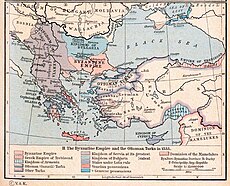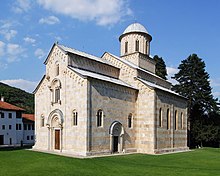 Global Information
Global InformationSerbia in the Middle Ages information
| History of Serbia |
|---|
 |
|
|



The medieval period in the history of Serbia began in the 6th century with the Slavic migrations to Southeastern Europe,[1] and lasted until the Ottoman conquest of Serbian lands in the second half of the 15th century.[2] The period is also extended to 1537, when Pavle Bakić, the last titular Despot of Serbia in Hungarian exile, fell in the Battle of Gorjani.[3]
At the time of settling, Serbs were already transitioning from a tribal community into a feudal society. The first Serbian state with established political identity was founded by prince Vlastimir in the mid-9th century. It was followed by other Serbian proto states, unstable due to the constant clashes with the Bulgarians, Hungarians and Byzantines, and by the conflict between Rome and Constantinople regarding the Christianization with the Byzantines getting the upper hand in the 9th century.[4][5][6]
By the second-half of the 10th century Principality of Serbia, enlarged but unconsolidated, prone to the internal tribalism and foreign attacks, collapsed leaving Serbian lands to the plunderers.[4][5] Serbian statehood moved to Duklja, which at one point reunited almost all Serbian lands, but the Byzantines successfully sidelined it.[5][6][7] The stable, unified, and continuous Grand Principality of Serbia was established in the late 11th century by Vukan. While under the rule of Stefan Nemanja and his descendants, the Nemanjić dynasty, Serbia achieved its Golden Age which lasted until the 14th century, when as a powerful state (kingdom from 1217, empire from 1346), it dominated the majority of the Balkan peninsula.[4]
By the 14th century, Serbia was a fully developed feudal state.[5][7] Foundations were set by King Milutin (1282-1321), the most important Serbian medieval ruler, who halted expansion of state in 1299 in order to consolidate it.[6][7] Serbia peaked during the reign of king and later Emperor Dušan (1331-55). He expanded the state to encompass modern Serbia south of the Sava and the Danube, Macedonia, Montenegro, Albania, east Herzegovina, Epirus and Thessaly, organized Serbia after the Byzantine Empire, and introduced codified law.[4]
There was a tight union of state and church which became autocephalous in 1219 under Saint Sava, and a patriarchate in 1346, rivaling the status of Ecumenical Patriarchate in Constantinople. The rulers endowed numerous monasteries, like Mileševa, Peć, Morača, Sopoćani, Visoki Dečani, Gračanica, which are today monuments with an important symbolism for Serbs. The union accelerated cultural development and moved beyond the realm of simply translating Byzantine works and established a unique Serbian civilization. Political and cultural growth was followed by economic growth. Agriculture developed; and while silver, tin and copper had been mined during the Roman era, mining vastly expanded in this period. Trade boomed as well utilizing old Roman roads.
The apex was short-lived. Dušan's death was followed by disintegration of state under rival family branches and local leaders.[4] The last emperor, Uroš, died in 1371. The major pretender to the unified throne was King Vukašin, but he died clashing with the Ottomans in 1371. The next who appeared able to restore Serbia was Prince Lazar Hrebeljanović, ruler of the expanded Moravian Serbia.[6] The major clash with advancing Ottomans occurred on 28 June 1389 at Kosovo Polje. Both rulers, Sultan Murad I and prince Lazar, were killed in the battle. Due to its importance, magnitude, and consequences, the battle, its participants and circumstances were enshrined and immortalized in folk poetry and literature. It transcended the historical importance, reaching a spiritual level by the 19th century, and turned Kosovo into the "Jerusalem of the Serbs".[4] Despite the defeat,[5] Serbia endured for another 70 years, experiencing a territorial and cultural revival under Despot Stefan Lazarević (1389-1427).[6][7] Serbian resistance continued until the fall of Smederevo in 1459.[4]
Despite the claimed significance in which Turkish rule shaped national consciousness of the Serbs, the fall under the Ottomans was dubbed by the Serbian historians as “Turkish night”.[4] The conquest severed continuity of economic, social and political development,[7] and Serbia was cut off from the European cultural and political society where it was carving its own place. When development of Serbia and the rest of Europe in the 15th and the 19th century are compared, it shows the enormous erosion and falling behind.[8]
- ^ Ćirković 2004, pp. 7–15.
- ^ Ćirković 2004, pp. 105–110.
- ^ Jireček 1918, pp. 263–264.
- ^ a b c d e f g h Allcock & Lampe 2023.
- ^ a b c d e Blagojević 1986.
- ^ a b c d e Stamenković et al. 2008.
- ^ a b c d e Šentija 1981.
- ^ Ćirković 2004, pp. XXIV, XXVI.